Environmental Feasibility Studies by McFadden Engineering
July 28, 2023

A feasibility study is an analysis of the likelihood of a project being successful. The “success” of the project is primarily dependent on ROI and whether the return is high enough for a project to be considered worthwhile. While a good return is seemingly the benchmark for a successful study, there are multiple factors for completing a feasibility study, including environmental regulations, impacts and possible repercussions. This month’s blog focuses on the steps needed to conduct a successful environmental feasibility, and how McFadden can conduct your company’s next environmental feasibility study.
Step One: Identify Regulatory Aspects of Project
Step one involves the identification of all regulatory aspects relevant for obtaining the needed environmental approvals. This requires an analysis of the project location and application as well as federal, state, county and local regulatory components. The following are questions that must be answered prior to step two.
- What are the stages for environmental approval?
- What is the level of detail and time required in each of those stages?
- What is the scope of the environmental assessment needed for the project stage approvals?
- How long will the regulatory process take, considering the overall project scope?
Step Two: Identify Environmental Impacts of Project
Step two involves thorough due diligence to identify, describe and quantify the environmental impacts of the project. McFadden Engineering offers expertise in the following services making the impact analysis a digestible process for your company.
- Environmental Compliance
- Environmental Engineering
- Site assessment and Remediation
- Water Quality and Hydraulic Modeling
An analysis of the project’s environmental impact on the area including direct and secondary impacts, immediate or long-term effects and temporary or permanent consequences is necessary for a comprehensive impact analysis.
Step Three: Develop Strategy to Mitigate Impacts and Overview of Project Environmental Plan
Step three involves development of a strategy to mitigate project environmental impacts including the development of plans to minimize the most significant environmental effects. These include feedback of project technical requirements to alter aspects of the design and determine if modifications can reduce environmental costs. As well as a cost assessment of the necessary items identified in steps one and two to calculate overall project environmental ROI.
At McFadden Engineering, our team of talented engineers and geologists have more than a century of combined civil and environmental experience. Our company is a combination of engineering and environmental experts working together to generate environmentally sound solutions to water, wastewater and civil engineering problems. To learn more about our work, contact us at 251-470-6870.
Five Tips for Developing a Safety-First Mindset
June 27, 2023
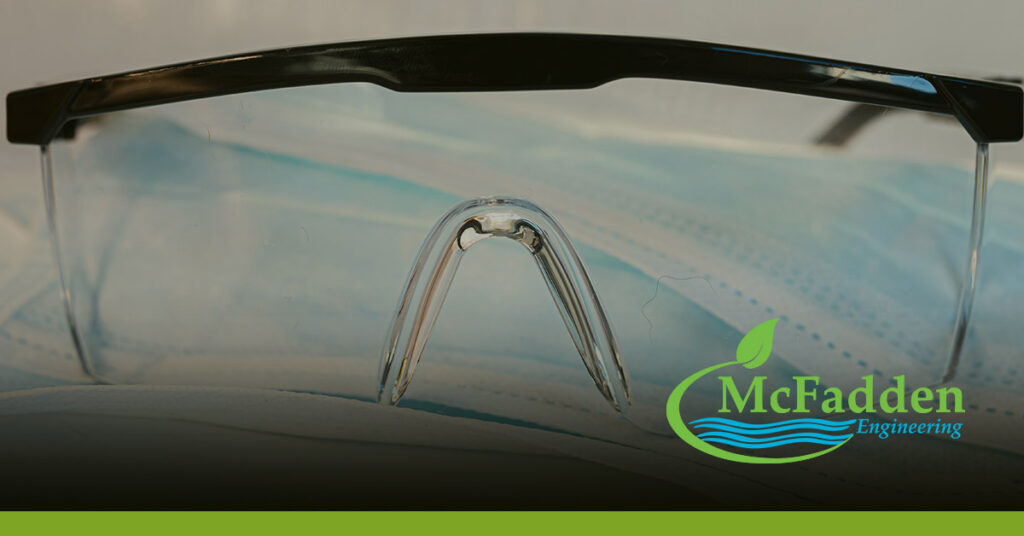
With a wide range of expertise throughout various sectors of the engineering industry, McFadden Engineering boasts experience in a variety of service areas. From involvement in facility management to wastewater treatment process evaluation and design, McFadden Engineering is familiar with wastewater treatment plants and the operation of those facilities. No matter the plant setup or the job within the plant, one thing remains constant throughout the industry. Developing and maintaining a “safety-first” mindset while on the job is the most important tool our engineers try to impart to our clients.
Having a safety-first mindset means being aware of your surroundings. When working in an municipal or industrial wastewater treatment facility, it is important to remember you are working with equipment and chemicals that can be dangerous if not operated safely and correctly. It is important to keep this mindset to ensure your own safety as well as the safety of others in the workplace. With more than 5,000 fatal work injuries occurring in 2021, it is important to create a safety-first environment. Here are a few ways that McFadden employees implement safety in every project that we perform.
Wear Personal Protective Equipment (PPE)
Wearing safety equipment means protecting yourself and those around you. Personal Protective Equipment (PPE) is equipment worn to minimize exposure to hazards that cause serious workplace injuries and illnesses. Personal protective equipment may include items such as gloves, safety glasses and shoes, earplugs or muffs, hard hats, respirators, or coveralls, vests and full body suits. Employers should also train each worker required to use PPE so that they know when it is necessary, what kind of PPE is necessary, how to properly use the PPE, the limitations of the PPE and the proper care, maintenance, useful life and disposal of the equipment.
This equipment is used to help prevent injuries and illnesses that may result from contact with chemical, radiological, physical, electrical, mechanical or other workplace hazards. Occupational Safety and Health Administration (OSHA) standards require specific PPE be used in certain settings (i.e. general industry, maritime, construction, etc.)
Use of the Proper Equipment and Machines
One of the most common ways injuries unfold in an industrial work environment is through contact with machines. In 2020, there were more than 195,000 nonfatal injuries involving contact with objects and equipment. It can be easy to fall into a dangerous, yet convenient routine when operating equipment. Remaining vigilant and being aware of proper operating procedures while working with machines could be the difference between injury and safety.
Knowing Your Workplace
Being prepared for unpredictable situations is one of the most important things you can do in the workplace. It is critical to know the locations of the nearest emergency exit, eye wash stations and other designated areas that prevent or aid in emergency situations. In the event of an emergency, know who to immediately inform, where they are located and the muster point of your facility.
Be Aware of Your Surroundings
Being aware of your surroundings is key to any workplace, especially in an industrial facility. This can involve anything from remembering to take breaks after long periods of work or using drip pans and guards when dealing with potentially hazardous liquids. Awareness also includes keeping your work area clean, keeping exits and walkways unobstructed and keeping your equipment organized and in the proper storage area. While some things may seem redundant and silly, remaining conscious and mindful of the little things can help make your job easier and keep you and your coworkers safe.
Be a Team Player
Being a team player means looking out for the safety of others in your workplace. This does not always require brave heroics but can be as simple as speaking up to supervisors about unsafe conditions. Although it may not seem like much, preventing falls in any form is a huge service, with more than 210,000 workers missing time in 2020 alone from fall-related injuries. Good communication with your coworkers is also important especially when working in a dangerous environment.
A certain threat or risk is innate and expected when working in an industrial environment. McFadden Engineering is committed to creating the safest workplace possible. By developing and maintaining a safety-first mindset and utilizing these tips, you can help make your work environment safer.
For more information about McFadden Engineering’s Facility Management and Operations services, click here or contact our team.
Water and Wastewater Process Consulting: Enhance Your Wastewater Treatment Plant’s Efficiency with On-Site Engineering Consultants
May 26, 2023

As a manufacturer or someone that occupies a space in the industrial sector, your process will likely create byproducts. In many cases, these are water or wastewater that will be regulated on a local, state or federal level. At McFadden Engineering, we realize that achieving environmental compliance can be challenging with your expertise focused on other areas of your organization. McFadden Engineering excels in providing a streamlined process through safe, cost-effective and innovative solutions while helping your organization achieve compliance.
Wastewater treatment plants include numerous individual treatment processes within the overall treatment train. Each of these individual processes has optimum operating conditions that allow them to efficiently handle the specific parameters which the process is designed to treat. The misalignment of one of these parameters can result in a treatment process that is costly and difficult to maintain. In a worst-case scenario, your wastewater process can fail completely and potentially lead to environmental compliance issues and poor effluent water quality.
At McFadden Engineering, we offer consulting services to your organization providing the ability to conduct an analysis and review your current process, access equipment and implement process optimization.
Process Optimization
The first part of wastewater treatment process optimization includes a thorough evaluation of the process parameters that affect your wastewater treatment process. During this evaluation, our team of engineers and wastewater operators will assess lab data to detect how the plant is treating the wastewater. Additional testing and analysis can be conducted to evaluate the performance of the individual processes in the wastewater treatment facility. After we complete a thorough evaluation of your current process parameters, we can conduct an equipment analysis and test other components of your plant’s process.
Equipment Operation Analysis
A typical approach to equipment review involves three main objectives: conducting an equipment audit, identifying equipment issues and developing a plan to address the identified equipment faults. When equipment is evaluated by our team, we most often look at the yearly maintenance schedule to determine if the equipment is operating at its optimum level. An equipment audit review is an integral part of any organization’s wastewater treatment plan. Our equipment review findings can give us a glimpse into your plant’s wastewater treatment facility process and identify ways we can implement, upgrade or benchmark your plant’s process optimization. Based on the findings, McFadden Engineering can develop a plan for operational adjustments, equipment upgrades as well as possible additions to the treatment process.
Overall Operation Assessment
Performance assessment is an integral tool for wastewater treatment plants to operate on a cost-effective and sustainable basis. After the necessary wastewater treatment facility parameters have been evaluated and an action plan has been developed and implemented to address the outstanding equipment needs, our team will assess the wastewater plant operation. This includes a thorough review of monthly reporting to regulatory agencies and daily lab data, if available. In addition, maintenance logs and equipment history are usually very helpful in evaluating issues. Our team will also develop a list of priorities to determine which plant objectives to tackle first. In some instances, recommendations could include additional site training for the facility’s operator and staff.
Throughout this process, it’s imperative that our personnel interact with your plant’s operational team to maintain a pulse on your plant’s progress with the goal of achieving efficient and smooth-running system operation.
Conclusion
All wastewater treatment facilities strive to reach their maximum outputs while maintaining an efficient operation. Optimization can take many different forms, meaning anything from hiring additional wastewater operators to incorporating additional treatment processes to meet the overall needs of the facility. We’re here to serve as allies for your wastewater treatment plant to help you achieve efficiency and meet regulatory compliance.
For more information about McFadden Engineering’s Facility Management and Operations services, contact us for a site visit.
Alabama Wastewater Treatment Operator Continuing Education Training Sessions
April 28, 2023

The wastewater treatment process is complex. Facility management and operations is a specialty service offered by McFadden Engineering to help our clients minimize the burden of maintaining facilities and wastewater treatment operations. Not only do we offer process support and design/build consultation services, but we also offer support to the men and women who operate wastewater treatment plants, both municipal and industrial, across the state of Alabama as well as many other states.
State Plant and Operator Requirements
The Alabama Department of Environmental Management (ADEM) requires the following Staffing Requirements. All Water Treatment Plants, Wastewater Treatment Plants, Water Distribution Systems, and Public Wastewater Collection Systems are required to be operated by an Operator certified, in accordance with the provisions of this Division, as competent to operate the plants or systems to which the plant or system is classified.
Those entering a career as a wastewater operator begin as operator interns and after passing required exams, move into the following certification levels: Certified Operator Grade I, Grade II, Grade III and Grade IV. Operators are required by the state to obtain continuing education hours.
Alabama Wastewater Operator Continuing Education Requirements
According to ADEM, Alabama’s certified water and wastewater operators are required to take continuing education classes during each three-year certification renewal cycle. During each three-year period, operators must attain a minimum number of Continuing Education Hours (CEHs), described in ADEM’s Division 10 regulation.
As a service, McFadden Engineering offers on-site continuing education training sessions. These sessions are led by Jimmy Wiggins, a Grade IV Certified WWTP Operator at McFadden Engineering. Jimmy works with the client, Alabama Water Pollution Control Association (AWPCA), the governing agency for training and certifications and ADEM to develop training topics and ensure the curriculum is pre-approved. The McFadden team works to tailor each training to the needs of the operator class.
Previous training topics include:
- Chlorine Safety
- Grade 2 test prep
- Biosolids
- Liquid process
- Safety
The McFadden Engineering team of wastewater treatment experts have more than 100 years of combined experience and have been exposed to many issues and problems that individual facility operators likely have not encountered. We’re here to help operators as an ally, solve unique problems and provide training to give them the comfort level to work confidently within their facility. We take pride in both problem-solving and building operator confidence through training and expert guidance.
For more information about McFadden Engineering’s Facility Management and Operations services, click here or contact our team.
World Water Day
March 24, 2023
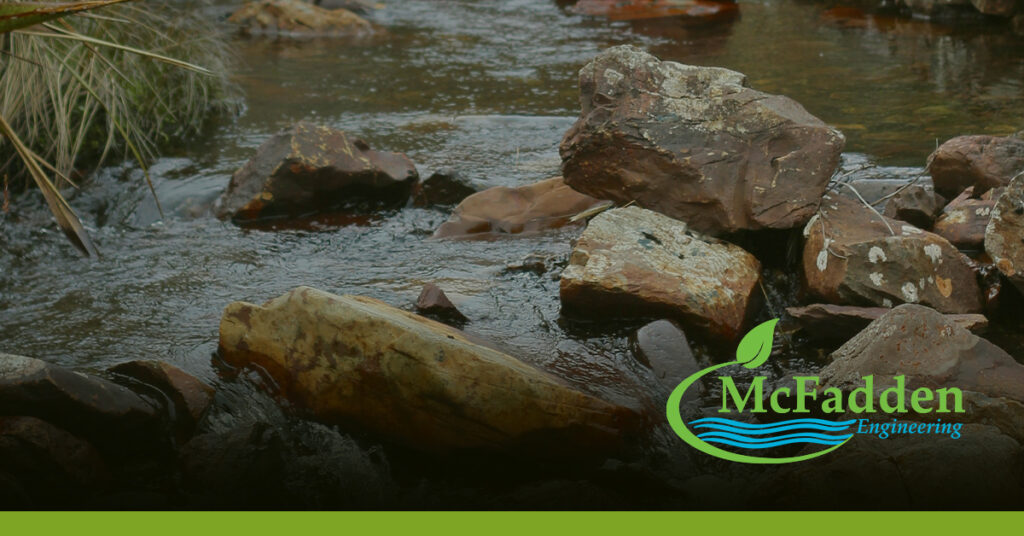
World Water Day is not only about recognizing, educating and advocating for access to clean water. It’s also about understanding the issues that impact water resources around the world, including McFadden Engineering’s home state of Alabama.
In 2021 we launched a blog, Managing Alabama’s Natural Resources. Did you know the state of Alabama boasts 16 distinct river basins; 129,700 total miles of rivers/streams; 59,000 miles of perennial (i.e., streams that flow year-round) rivers/streams; and 490,472 acres of lakes/reservoirs/ponds? The responsibility of managing these bodies of water and the effluent that enters these bodies is not just in the hands of the state but is a responsibility of citizens and professionals to be good stewards of our available water resources.
The blog explains that with this abundance of water comes the obligation and duty to manage these vital natural resources to protect them for future generations. That duty has been promulgated by the Federal Water Pollution Control Act Amendments (FWPCA, PL-92-500) in 1972 to each state where management and enforcement duties were implemented. The McFadden Engineering team is proud to support federal, state and local agencies who govern and regulate these efforts and the municipalities and industries who work diligently to not only utilize but protect these resources as well.
The McFadden Engineering team has spent decades developing innovative systems to solve our states most challenging water and wastewater problems. The McFadden team has extensive experience in developing water reuse systems to conserve and optimize the usage of this abundant natural resource. In addition, McFadden Engineering has a history of developing and improving wastewater treatment process solutions. In 2016, the team introduced a water treatment system designed to remove 98% of the typical wastewater contaminants. Our team works daily with clients throughout North America evaluating and implementing solutions to assist with water reuse and addressing challenging issue that impact our waterways.
Read more about McFadden Engineering’s impact on water in the state of Alabama in a recent case study Rain Drop Car Wash Installs McFadden Engineering’s OxyShark® Water Reclamation System.
Contact McFadden Engineering and our team of professional engineers and geologists to evaluate and solve your civil and environmental engineering issues. Learn more about our breadth of engineering services and contact us for more information.
Engineering ROI: Why Hiring a Third-Party Engineering Firm Pays Off
February 21, 2023

For McFadden Engineering clients, hiring a third-party engineering firm offers benefits that increase the overall return on investment (ROI) for the project. Not only do our clients receive additional assistance meeting deadlines and completion timelines, but the knowledge, experience and broad range of specialty services that MEI offers provides insight that turn issues into solutions. McFadden specializes in providing efficient, responsible and cost-effective solutions. Our team of engineers is multi-skilled and multi-disciplined and works closely with our clients to solve environmental and civil engineering challenges.
Receive an Outside Perspective
Too often, teams are focused on completing a project or identifying one solution and may lose perspective regarding solution effectiveness, recent innovations and long-term problem identification. Turning to a trusted outside engineering firm will bring a fresh perspective and an experienced team to your project. Sometimes even the simplest problems may go unidentified and cause unwanted surprises once the project is complete. Bringing in an outside perspective can often uncover issues with your project that your team never considered or does not have experience addressing.
Work with Specialists
Sometimes you need a specialist to design or work on a small aspect of your engineering project. While it may not make sense to bring them on for the entire project, hiring an engineering specialist for contractual work can give you the results you need while saving your project money. McFadden Engineering has experience working with other professionals to address specific aspects of projects such as NPDES permitting, wastewater treatment or meeting water reuse requirements. McFadden Engineering’s team of professional engineers and professional geologists solve unique challenges through an integrative and innovative approach to environmental and civil engineering. Our team understands advancing technologies and changing regulatory landscapes and works diligently to employ cost-effective and technically proven solutions.
Strategic Partnerships
Engaging with McFadden Engineering as a third-party engineering service also brings relationships with a large spectrum of companies and equipment suppliers. We have relationships with strategic partners that your company may not have and are able to leverage these relationships to help our clients meet timelines and navigate permitting and regulatory challenges.
When your project’s success and more importantly, ROI is at stake, trusting an experienced engineering partner is non-negotiable. Contact McFadden Engineering and our team of professional engineers and geologists to evaluate and solve your civil and environmental engineering issues. Learn more about our breadth of engineering services and contact us for more information.
McFadden Engineering Civil and Environmental Engineering Services Overview
January 20, 2023

As a new year begins, it’s important to regroup and take stock of the services we offer and the impact we have helped our clients make in the community. McFadden Engineering is a 35-year-old firm, that provides environmentally sound solutions to solve the unique engineering needs of our clients. We are licensed to serve clients in Alabama, Florida, Georgia, Louisiana, Mississippi and Tennessee. Our technical staff has a cumulative 120 years of experience solving water and wastewater problems.
Civil Engineering and General Services
McFadden Engineering offers civil engineering services to commercial and industrial clients of all sizes. With a multi-disciplinary approach, we offer services such as development master planning, grading and drainage plan development, detention and retention design and stormwater management.
Read more about our work with Mobile Memorial Gardens.
Site Assessment and Remediation
McFadden Engineering is a leader in providing timely environmental site assessments to determine the existence of any environmental liabilities. Professional assessments include assembling public site records, leading physical site inspections, conducting interviews and performing additional steps as requested by the client, all conducted in accordance with established ASTM guidelines. Should an initial assessment reveal environmental problems, McFadden Engineering has the expertise to aid in conducting further investigation of the site (Phase II Site Assessment) as well as determining and implementing appropriate solutions.
Read more about our site remediation work at a manufactured gas plant facility.
Environmental Engineering Services
McFadden Engineering provides general environmental engineering services aimed to protect the environment from the impact of both natural and human activities. Our broad environmental engineering experience includes the development of best management practices for facility compliance, spill and response plan development for industrial clients and determining treatment alternatives for meeting permitted discharge limits.
Read more about our permit work with Master Boat Builders.
Environmental Compliance
McFadden Engineering has excellent established relationships with local, state and federal regulatory agencies and navigates the regulatory environmental permitting process on our client’s behalf, saving time and capital. Performing compliance audits for our clients assists them in meeting legal obligations for environmental performance.
Learn more about NPDES permits and the clients we assist with their ongoing permit compliance.
Water Quality and Hydraulic Modeling
McFadden Engineering has been on the leading edge of water quality modeling for more than 30 years, helping to develop some of the first water quality models used by the Alabama Department of Environmental Management (ADEM). Water quality modeling can be used to estimate the environmental impact of factors such as wastewater treatment plant discharges, industrial activity and commercial site development.
Read more about our work on the restoration of New River Bayou and its overall impact on Lake Pontchartrain.
Water and Wastewater Treatment
McFadden Engineering has extensive experience in managing drinking water and wastewater treatment. As a leader in water and wastewater process design in the Southeast, we deliver innovative systems to solve the most challenging problems. McFadden Engineering believes that by evaluating the water and wastewater needs of the client, a solution can be developed that specifically addresses the problem. No two clients are the same and our innovative approach to providing solutions expands our clients’ operational flexibility and allows for future growth.
Learn more about our work with Attalla Water Works Board (AWWB) to expand and upgrade its water treatment facility in Etowah County, Alabama.
Industrial Wastewater Treatment
Our goal for industrial wastewater treatment clients is to streamline treatment processes, achieve full compliance and ultimately reduce or eliminate surcharges and extra costs incurred from not meeting permit limits.
Read more about working with an Alabama poultry processing plant to solve their wastewater discharge issues.
Facility Management and Operations
McFadden Engineering offers facility management and operation services to ease the burden our clients face when tasked with maintaining general facilities and wastewater treatment operations for their organizations.
Our experienced Class 4 Wastewater Operator and engineering staff offer training, maintenance and full facility management to customers with small to medium flow wastewater systems, including schools, college campuses and small municipalities. We understand these organizations may not have a wastewater operator on staff, which is when McFadden’s team can step in and address those needs. McFadden Engineering can assess and maintain existing wastewater treatment operations and can also offer training and new management solutions for operators who may face recurring challenges on the job.
Learn more about our weekly management of the University of Mobile wastewater treatment system.
Contact McFadden Engineering and our team of professional engineers and geologists to evaluate and solve your civil and environmental engineering issues.
Top 3 Retention Tips Engineering Employers
December 19, 2022

In 2018 a detailed overview prepared by Deloitte, the number one accounting firm in the world, revealed a lack of skillful engineering specialists in the manufacturing industry. As engineering talent continues to be more difficult to find and retain, organization’s face uncertainty in managing future challenges. It is estimated that up to 2 million positions will be left unfilled over the course of the next few years. The key to success lies in retaining current and future engineering talent that are currently in the organization. McFadden Engineering has reviewed and created a list of our top retention practices we employ and are eager to share these practices with future team members and others in the engineering industry.
Prioritize Retention
Although it is seemingly common sense, it is not always easy to prioritize retention within an organization. A large percentage of recruiters in the engineering industry found the shortage of engineering skills has negatively impacted the hiring process and is becoming a complex challenge. With this challenge comes the opportunity to reflect on your organizations internal status and focus on optimizing partnerships with your technical staff. This is a great way for employers to retain their top professionals and work through any industry challenges that may arise.
Prioritizing implementation of retention practices in your organization will generate positive outcomes for current and future employees. Actively showing employees they are genuinely cared for as a team member drives a deeper passion for hard work to achieve overall success and growth of a company.
Upskilling
Upskilling is providing team members with learning and skills development opportunities. This has become an essential retention practice for McFadden Engineering and is an optimal way to solve the problem of limited engineering skills. In 2019, Glassdoor conducted interviews with engineers to uncover what they appreciated most in an employer. Results showed a diverse training program was one of the things they valued the most. Largely due to the time invested in implementing training , employees feel as the company is dedicated to continuously improving company culture. Utilizing upskilling practices can incentivize engineers to shift their focus on skill development which will also progress their careers. In return, upskilling helps employers develop potential leaders within the organization while creating employee loyalty.
Pay Attention to Personality Types
In the engineering industry, having a diverse workplace is crucial for the creation of efficient ideas and solutions. However, it is important to harness diversity for your organization’s benefit. The first step in managing your company’s diversity is focusing on establishing a working relationship with each member of your engineering team. This allows you to get to know each employee and gain insight to how they work. Creating meaningful work relationships proves to employees that they are valued and play an important role in the company. Understanding the dynamic of a team and recognizing each member’s areas of expertise is critical in maintaining a strong group mentality.
Employers should find time to observe team interactions and the personality types present in the workspace. Observations will most likely show a mixture of personalities with some employees demonstrating dominance when communicating (extroverts) while others display a reserved demeanor and rarely initiate conversations with colleagues (introverts). Once team diversity is recognized, it is our job to help facilitate an environment where both personality types possess equal opportunities to express their points of view. When retaining introverts, you should encourage them to speak up so they know their ideas and contributions are welcomed and appreciated. Extroverts typically have no problem saying what is on their mind. In this case, the task is to challenge them to contemplate more and encourage them to pause before speaking, which will create a more balanced dialogue within the organization.
At McFadden Engineering, our team of talented engineers and geologists have more than a century of combined civil and environmental experience. Our company is a combination of personality types working together to generate environmentally sound solutions to water and wastewater problems. To learn more about our work, give or become a team member give us a call at 251-470-6870.
Low Flow Groundwater Sampling – The Industry Standard
November 22, 2022
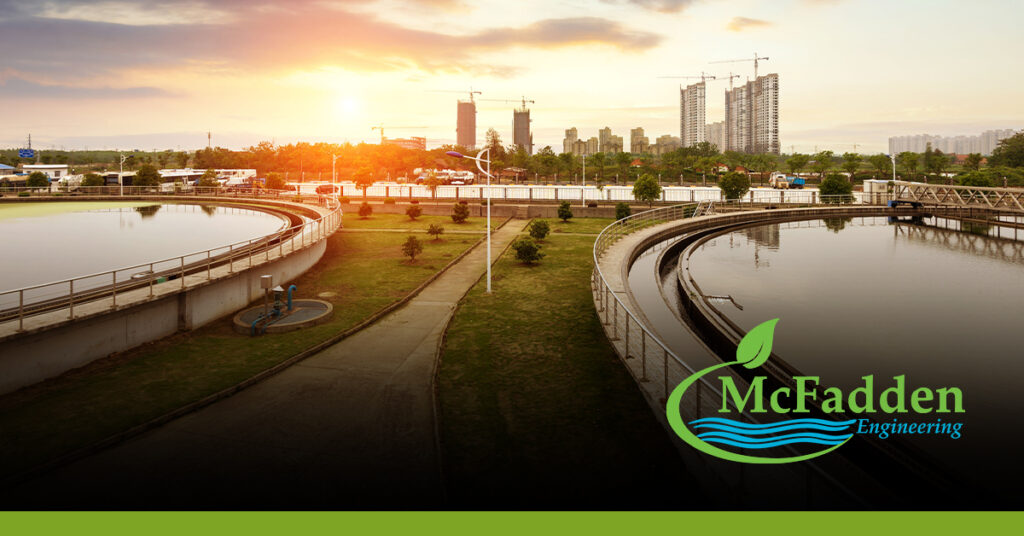
The methods and objectives of groundwater sampling to assess water quality has evolved. Why do we sample groundwater? Typically to access environmental impacts to soil and groundwater from chemicals of concern (COCs) or volatile organic compounds (VOCs).
This can be a challenging task for geologists and engineers and one that is not always easily accomplished. Since the mid-1990s, low-flow sampling has become an increasingly popular method for obtaining high-quality groundwater samples and has become the established method for providing the most accurate groundwater sampling data for assessment purposes.
Traditional Groundwater Sampling
Before low-flow sampling technologies were implemented, the most common groundwater and sampling methodology were to purge a well using bailers or high-speed pumps. This method involved removing three to five casing volumes and following up with a sample collection. This more traditional method can have adverse impacts on sample quality and has the potential to produce an overestimation of certain metals or organic compounds. Through the work of Robert W. Puls and Michael J. Barcelona, in 1996 the United States Environmental Protection Agency (USEPA) released standard operating procedures for low-flow sampling. Following such guidelines ensures the collection of samples that are representative of water conditions.
Low Flow Purging and Sampling Procedures
Low-flow purging and sampling involve extracting groundwater at rates typically less than 500 ml/min so that the drawdown of the water level is minimized. This method reduces the mixing of stagnant groundwater with groundwater from the screened intake area which ensures the sample is more representative of the aquifer conditions.
The sampling process involves collecting the depth of groundwater in each monitoring well so groundwater elevation can be established for that specific location. This sampling process plays a key role in ensuring that the evacuation rate from the monitoring well is properly adjusted and maintained during the purging and sampling process. Before the sample is collected, the stabilization of water quality parameters such as pH, DO, conductivity, temperature, oxidation-reduction potential and turbidity of the purged water is monitored. By allowing the aquifer to equilibrate before sampling, low-flow methods produce samples that are representative of the formation water.
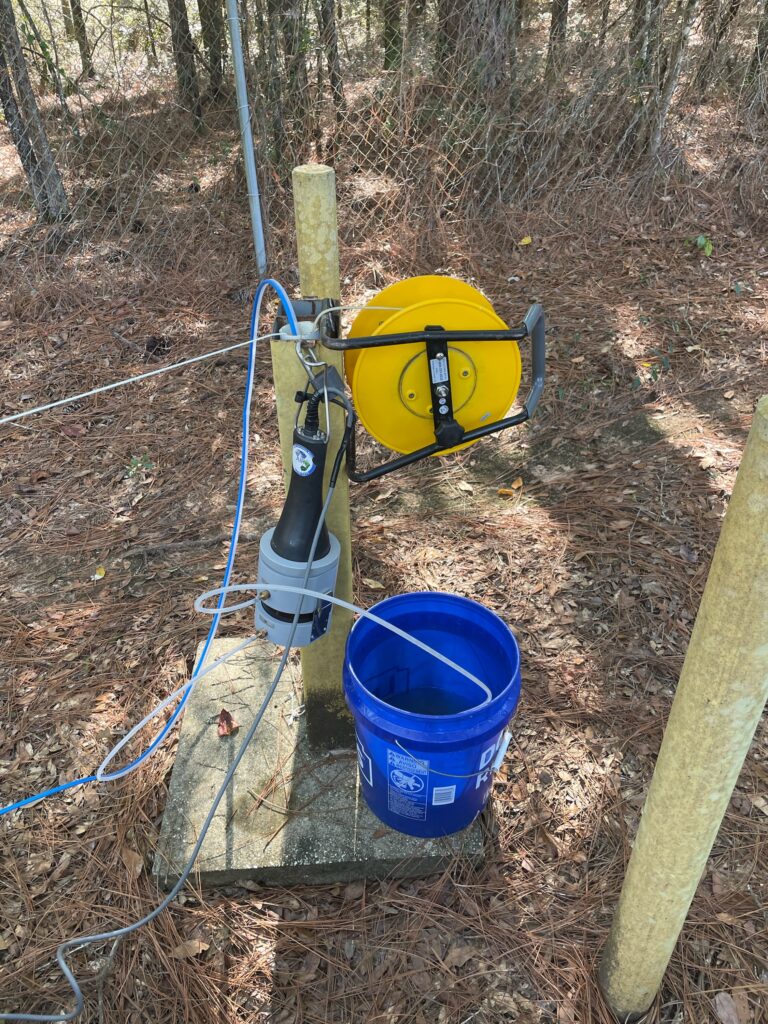
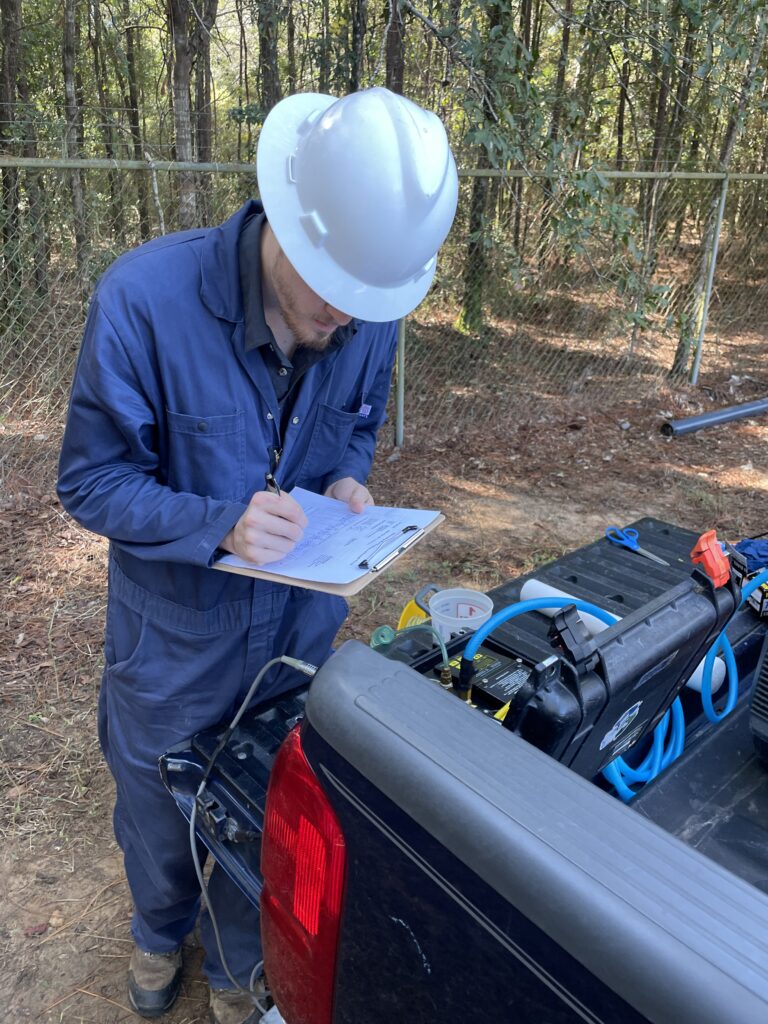
At McFadden Engineering, we implement the most effective and accurate environmental testing and solutions to water and wastewater problems, which is why we utilize low-flow purging methods on a variety of projects. To learn more about our work with low-flow purging, visit the links below or give us a call at 251-470-6870 or send us an email.
Rain Drop Car Wash Installs McFadden Engineering’s OxyShark® Water Reclamation System
October 27, 2022

OxyShark® Water Reclamation (OWR) is a wastewater treatment system used to treat domestic, commercial and industrial wastewater. OxyShark utilizes a high-rate biological process specially designed to produce reusable, nearly potable clean water.
Founded by a team of experienced water engineering professionals with a background in wastewater process design, OxyShark is a leader in the wastewater treatment world, distinguished by its speed and efficiency in completing the treatment process up to 10x faster and with a smaller footprint than traditional systems.
Car Wash Training Facility in Clay, AL
A customer came to the OxyShark team with a proposed car wash and car wash training facility in Clay, AL. The main challenge of this location was the lack of sewer connections in which to discharge wastewater. The expected capacity was 7,500 gallons per day (GPD) of car wash water generated at the site. Following a thorough design process, a two-unit system was designed and installed featuring Zeolite filtration and a 10,000-gallon equalization (EQ) tank. The large EQ tank was necessary to handle any temporary surges since there was no available sewer discharge connection. The customer’s goal was 100% water reuse less the approximate 17% losses due to evaporation and drive-off.
OxyShark also allows for a small city water usage at the car washes’ reverse osmosis filter for a spot-free rinse and an automatic city water make-up valve installed on the reclaim tank to replace water lost to drive off and evaporation.
From day one, the system exceeded expectations, as the customer is averaging 10,000 GPD due to a higher-than-expected traffic count. The system was able to increase the average flow through the OxyShark system beyond the design point to meet the increased demand. The customer reports clean water with no odor, good wash quality and efficient use of chemicals. Every three to four months, the McFadden team will purge the system with a small volume of city water. This helps reduce the build-up of dissolved solids in the reclaim water. Other than this quarterly purge and the small amount of spot-free rinse water, the system is 100% reclaim. The OxyShark microprocessor based 100% reclaim wash water system proved to be the best solution for this challenging car wash project.
In addition to this unique car wash application, OxyShark has proven to be an efficient treatment technology in many other commercial and industrial applications. If you are interested in learning more about potential applications for OxyShark treatment technology and the capabilities of our system, contact us at 251-470-6870 or visit our website. We look forward to working with you on any future potential projects.

